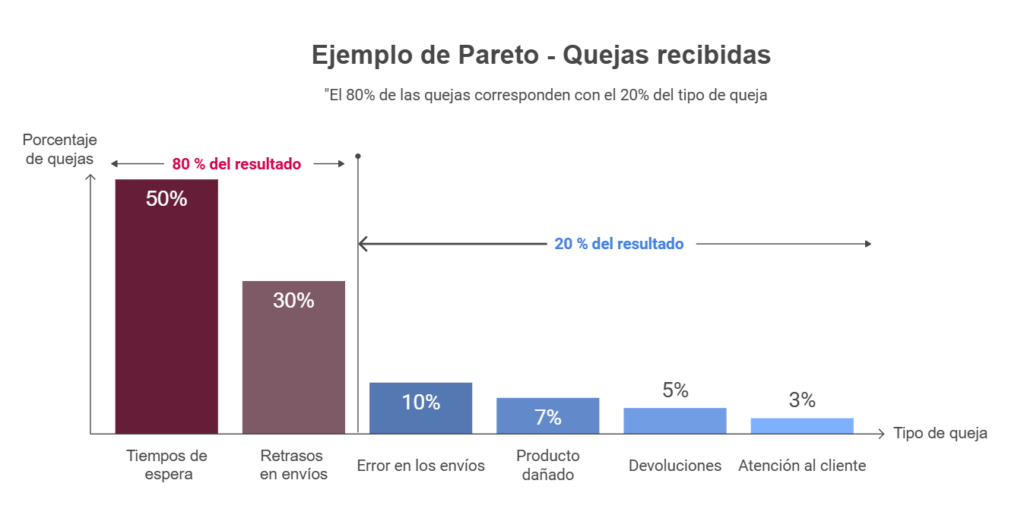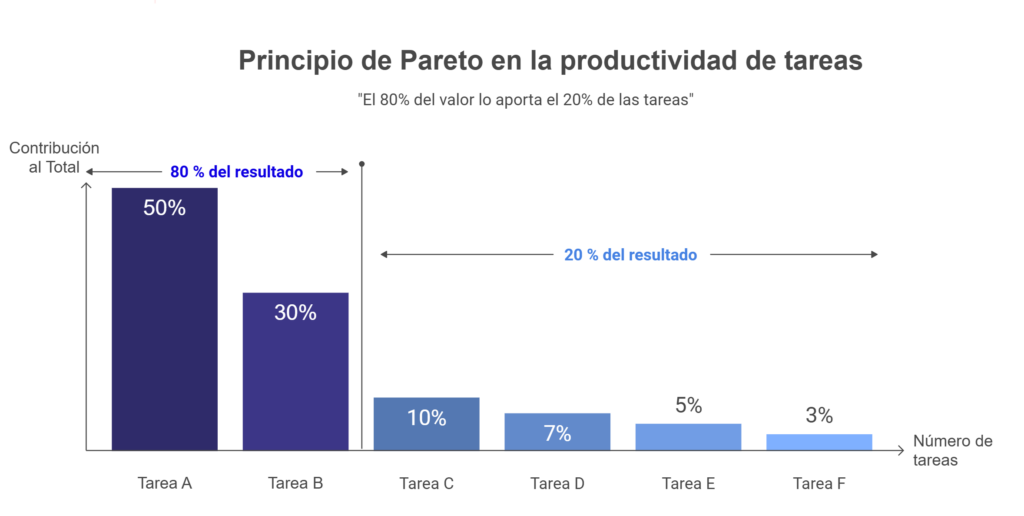
Has it ever happened to you that you spend 80% of your day answering emails and barely feel like you are making any progress on the really important work? If so, you have already experienced the famous Pareto’s Law. As absurd as the above, this law can be used in reverse to make it profitable. For example, in your company, this principle could be used to detect those few tasks that maximize your results, even if this means admitting that 80% of meetings only generate 20% of useful decisions (and that’s being generous!).
Pareto’s Law
Pareto’s Law is that principle that we all apply without knowing it. Have you ever heard that small details can make a difference? Those little things represent with this Law the 20%, which will generate 80% of the results. And although it is not always an exact proportion, the imbalance is as real as your endless to-do list.
Pareto’s law is deeply related to the principle of factor scarcity, which states that resources, whether time, money or effort, are limited. Since not every resource is distributed equally, only a small percentage generates the most results. This imbalance is the basis of 80/20, and we can see it in examples as disparate as job performance and even the frequency with which we use certain words in a language.
With this on the table, it seems obvious to focus on what really matters, this percentage of tasks that will maximize your results, instead of getting lost in the accessories. Because, let’s be honest, no one has unlimited time or desire to invest resources in things that barely produce results.
The key message? Not everything deserves your attention equally. Identify the 20% that really matter, and you’ll see how it changes the game.
Historical origin with Vilfredo Pareto
Pareto’s Law has a rather peculiar history. A 19th century Italian economist, Vilfredo Pareto, was studying how wealth was distributed in his country when he noticed that a small part of the population owned almost all the land. This small part of the population accounted for about 20% while almost all the land extended to 80% of Italy. The other 80% of the population was called the masses by Pareto, and it was how he staged the distribution of natural goods and the world’s wealth.

It was Joseph Juran who demonstrated this universal principle, showing its application in areas outside economics. For example, he applied it to quality, where 20% of the problems determined 80% of the causes, making it clear that, equally, 80% of the problems should not be ignored.
Applications of Pareto’s law in the business world
As we have seen, this principle is universal, and applies in countless areas. In the business world, for example, it can be seen in productivity, sales or marketing. Although it is a simple concept, its application is not so trivial, and its impact can be enormous when used to prioritize efforts. Pareto’s law suggests that the key to being more efficient is not to do more tasks, but to identify which tasks really generate value and prioritize them.
Marketing is one of the fields where Pareto’s law has the clearest applications. Many campaigns tend to be generalist and reach the largest number of customers, however there are a thousand examples that the most effective are those that focus on that niche of customers who are sure to buy your product, and thus do not dilute the effort in less profitable sectors. This customer niche will generate 80% of the profits and focusing campaigns on them makes it easier to manage resources to maximize profits. By identifying these key customers, companies can focus on building loyalty and offering them additional products or services, rather than wasting resources and efforts on lower value customers.
Even if we talk about the product, they could focus their business strategy on this market segment. Products with numerous features tend to be confusing and difficult to use, when probably not even 20% of the customers will end up using that 80% of extra features. This not only makes the product difficult to use and adopt, but also makes it more expensive for a user who will use one-fifth of its features. An overly aggressive strategy could result in significant investments for a relatively small profit margin.
Or, for example, an analysis of a company’s project portfolio may reveal that 20% of the projects are responsible for 80% of the return on investment. Instead of spreading investment across multiple initiatives, managers can make a strategic decision to focus on those key projects that will generate the greatest returns.
In the following graph we see how in a customer service two types of complaints represent 80% of the calls, waiting times and delays in shipments. Searching for the root cause of these two complaints would solve 80% of the service, instead of looking one by one at problems such as returns, which solve only 5% of the calls:

Curious examples of Pareto’s law in the office
Although this principle is generally used to optimize productivity, there are some examples that confirm how this principle can manifest itself in unexpected situations.
One of the examples you’ve probably experienced in your company is the fact that 20% of the attendees in an online meeting talk 80% of the time. The rest of the employees, meanwhile, remain silent, either because they are distracted, have nothing to add, or are simply pretending to pay attention. This small group of people dominate meetings, while the majority quietly go about their other tasks.
If you are in the office, and the office has a limited number of meeting rooms, chances are that it is difficult to book them, and 80% of the time it is because they are booked by only 20% of the people in the office, while the rest of the staff is forced to improvise meetings in the corridors, or even in the Office. The curious thing is that many of these rooms remain empty most of the time, but are blocked in the calendars, creating an “artificial” shortage of meeting rooms.

The curious thing is that in most companies there is a tendency to solve everything with meetings. However, of the total workday, 20% of the time is typically spent in coffee breaks, and these breaks generate 80% of the crucial social interactions and discussions for the company. While it may seem absurd, that small percentage of off-screen time drives the majority of informal strategic decisions.
Why is Pareto’s Law so important in Agile environments?
Agile approaches promote rapid and continuous delivery of value by prioritizing those tasks or user stories that have the greatest business impact, either maximizing value or minimizing problems. Applying Pareto’s law within this context helps to identify the features that generate the most business value with the least effort, thus optimizing time and effort, and providing focus to the team.
Pareto’s law, like Parkinson’s Law, is a very powerful law for understanding how to manage time and resources working in agile environments.
Prioritization of the backlog with Pareto’s Law
In Scrum, the Product Backlog is usually full of tasks, user stories, defects and other items that teams need to address. However, not all of these features have the same value or urgency. By applying Pareto’s law, the team can identify that typically only 20% of the backlog delivers 80% of the value to the business. What’s more, many of the items will probably never even come to fruition. Therefore, the key is to focus on those most important features to maximize the impact in each sprint.
Have you considered eliminating the rest? Here we would enter into a paradox, and that is, if you eliminate those functionalities that generate the rest of the 20% of value and keep the ones that produce the most value, you would also apply Pareto to these. The recommendation is, using the Pareto principle, identify those functionalities that generate more value, and from the rest, eliminate those that you do not foresee that they will be realized in a reasonable time, for example, in the next 3 to 6 months, and thus make room for emerging functionalities that can provide greater value.
Use of metrics and the Pareto diagram
The Pareto chart can be used to visualize bottlenecks that affect value delivery, whether in the form of defects, blockages or inefficiencies. This chart allows teams to focus their efforts on solving the most important problems that, according to the 80/20 principle, will have the greatest impact on sprint results.
This graph would represent a Pareto diagram, where 80% of the results are achieved by performing tasks A and B:

Other diagrams can also be useful to have KPIs that indicate if and how the team or product can improve, but remember to focus only on those diagrams or data that provide you with 80% of the decisions. The rest of the metrics are not KPIs and will only generate noise. Do you know the difference between metrics and KPIs? Here it is in this article: https://smartway.es/kpi-que-son/
Real case studies
The Pareto principle has been used by large companies to improve efficiency and maximize results. Some real cases have demonstrated how the 80/20 rule can transform an organization’s strategic approach:
- Microsoft and software bug reduction: Inan internal analysis, Microsoft discovered that 80% of the bugs in its software came from only 20% of the code. By applying Pareto’s law, the development team prioritized the review of that 20% of problematic code, resulting in a significant improvement in software quality and a considerable reduction in user complaints.
- General Motors and production optimization: One of the automotive giants discovered that only 20% of its factories were producing 80% of its vehicles. By implementing a strategy based on Pareto’s law, GM decided to optimize and automate these key factories, which not only increased production, but also reduced operating costs by 15% in the first two years.
- Apple and the focus on iconic products: Apple is famous for reducing its product portfolio when Steve Jobs returned as CEO. Applying the Pareto principle, Apple realized that 20% of its products generated 80% of revenue. Instead of continuing to develop a wide range of devices, the company focused on flagship products such as the iPhone and MacBook, which catapulted its profitability and global positioning.
- Pareto at Starbucks and store location: Starbucks applied Pareto’s law when analyzing customer traffic in their stores. They found that 20% of locations generated 80% of sales. This allowed them to optimize the location of new stores, closing unprofitable locations and focusing on opening more stores in high-traffic areas. This approach helped maximize their profits without increasing fixed costs.
- Google and advertising revenue optimization: Google applied Pareto’s law to its advertising platform, Google Ads. They realized that 20% of their advertising customers (advertisers) generated 80% of the revenue. This information allowed Google to customize its service to these key advertisers, offering premium solutions that improved both advertising results and the company’s revenue.




